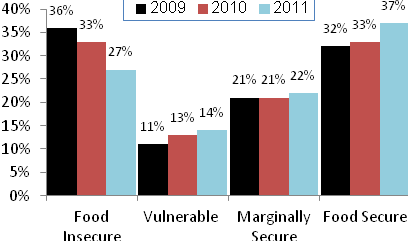Press Release by Palestinian Central Bureau of Statistics (PCBS) on World Environment Day
World Environment Day (WED) is celebrated annually on the fifth of June. The theme for this year is "Think, Eat, Save": a campaign to encourage the public to reduce their food print by cutting food waste and loss.
This year’s theme encourages the public to become more aware of the environmental impact of food choices and to make well-informed decisions.
While the planet is struggling to provide the resources to sustain 7 billion people, FAO estimates that a third of global food production is either wasted or lost. Food waste is an enormous drain on natural resources and a contributor to negative environmental impacts. It is estimated that 550 billion m3 of water are used in the production of wasted food.
So the message is, think before you eat and help save our environment.
In compliance with this principle; it would increase awareness of food security issues, especially for those who lack food security, as on case in Palestine.
Food Security
According to FAO, food security exists when all people, at all times, have physical and economic access to sufficient, safe and nutritious food to meet their dietary needs and food preferences for an active and healthy life.
This widely-accepted definition comprises the following aspects of food security including; Food availability: the availability of sufficient quantities of food of an appropriate quality, supplied by domestic production or imports. Access to food: access by individuals to adequate resources to acquire appropriate foods for a nutritious diet. Utilization: use of food in an adequate diet, clean water, sanitation and health care to obtain a state of nutritional well-being where all physiological needs are met. Stability: to be food secured, as a population, household or individual must have access to adequate food at all times.
Palestine and Food Security
According to classification of the World Food Program, FAO, and UNRWA, on Palestinian households with regard to food security; a total of 1.3 million people representing 27% of households in Palestine remain food insecure[1] in 2011, an additional 14% of the households are vulnerable[2] to food insecurity, 22% are marginally[3] secure and 37% are food secure[4]. It is important to note that food security rates include the impact of any assistance received during the reference period.
Food Security Levels in Palestine, 2011

Over the last 3 years, the percentage of food insecure households had declined from 36% to 27%. This decrease was translated into 3% increase in vulnerable households, 1% increase in the percentage of marginally secure households and 5% increase in the percentage of food secure households who represented 37% of the Palestinian households.
Food Security Levels in Palestine, 2009- 2011

Food Prices and Food Security
The Consumer Price Index (CPI) is an official measure of inflation in Palestine and is used to monitor change in the cost of a basket of food and non-food goods and services. Food makes up almost 38.0% of the CPI, making it a key determinant of inflation in Palestine. The sharp rise in the CPI between 2007 and 2011 in Palestine reflects the impact of international food and fuel prices on the domestic market. From 2007 to the end of 2011, CPI rose by 20.5% in Palestine (19.0% in West Bank, 22.0% in Gaza Strip).
Trends of Food Price Index in Palestine, Jan – March, 2013 )2004=100)

Source: Palestinian Central Bureau of Statistics, 2013. Consumer Prices Survey, 2013. Ramallah – Palestine.
Safe Food and Food Security
Access to safe food is in itself an element of food security since the existence of polluted or unhealthy food is related to the concept of food insecurity.
Decision makers in Palestine have devoted considerable attention to food safety to protect the public’s health and ensure the safety of food and medicine.
[1] Household with income and consumption below USD 5.39 / adult/day
[2] Households with both income and consumption below USD (5.39 - 6.76)/ adult/day
[3]Household with either income or consumption above USD 6.76/ adult/day (not both)
[4] Household with income and consumption above USD 6.76/ adult/day
 عربي
عربي